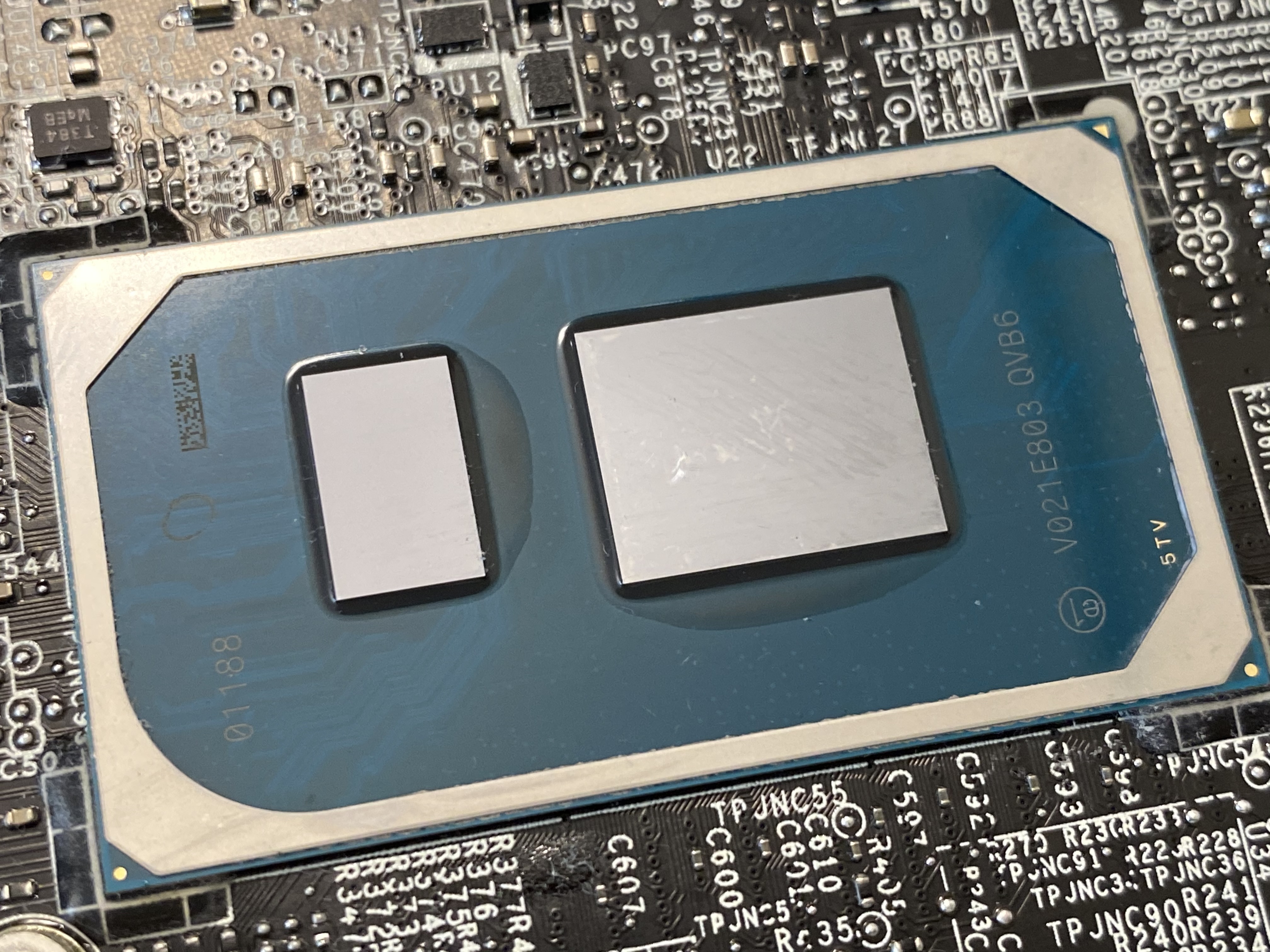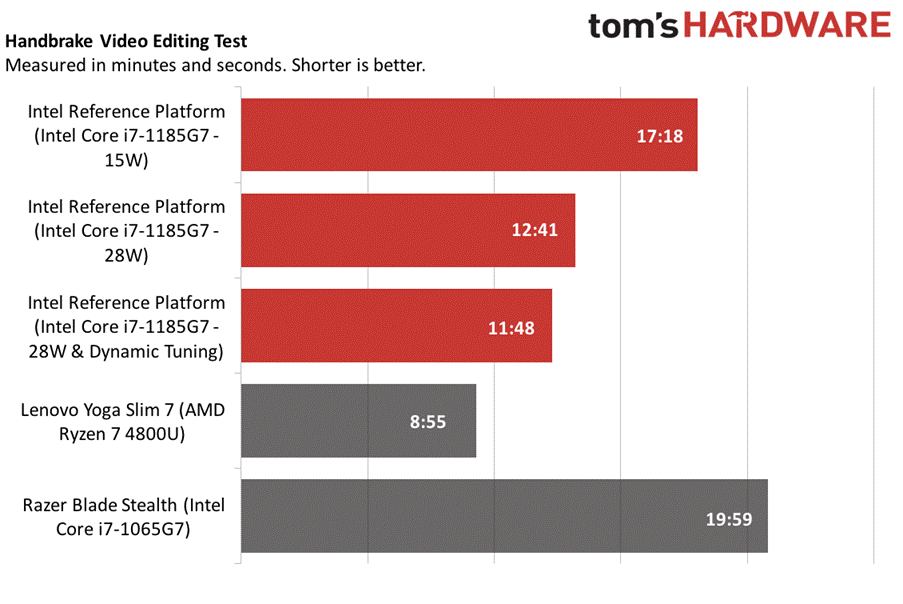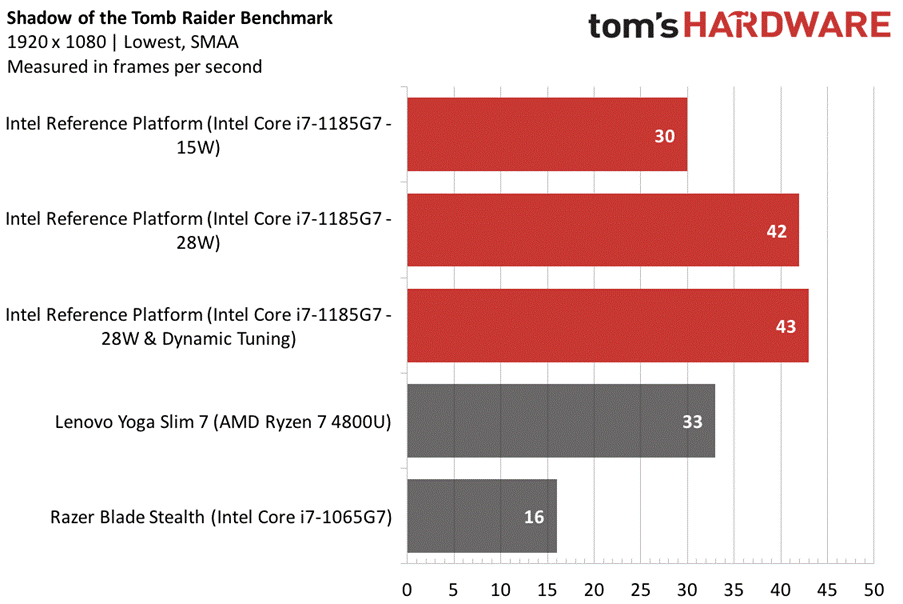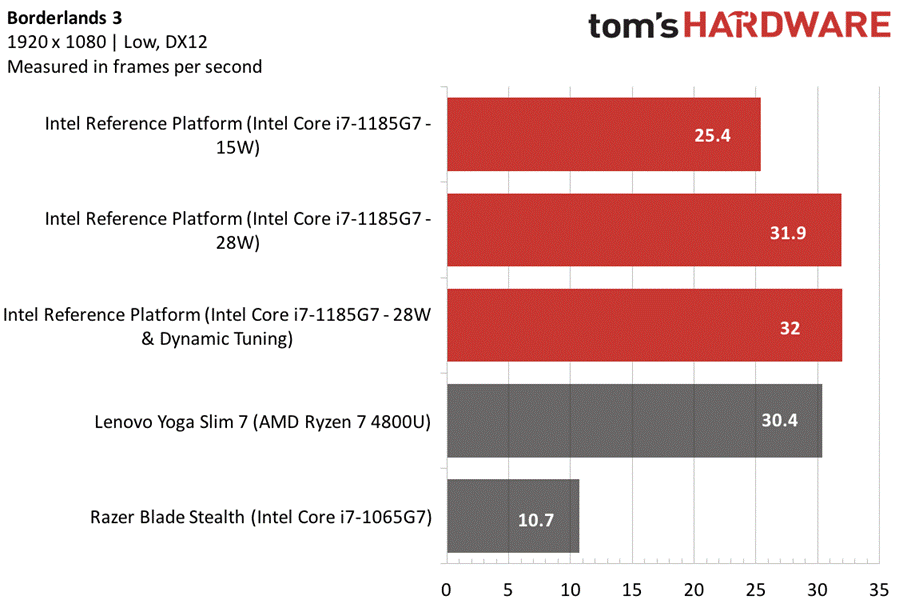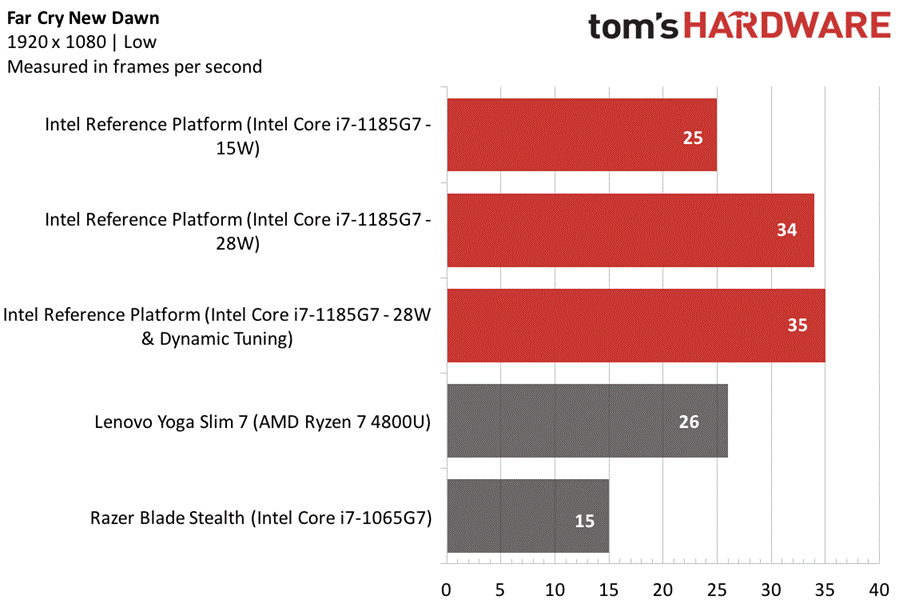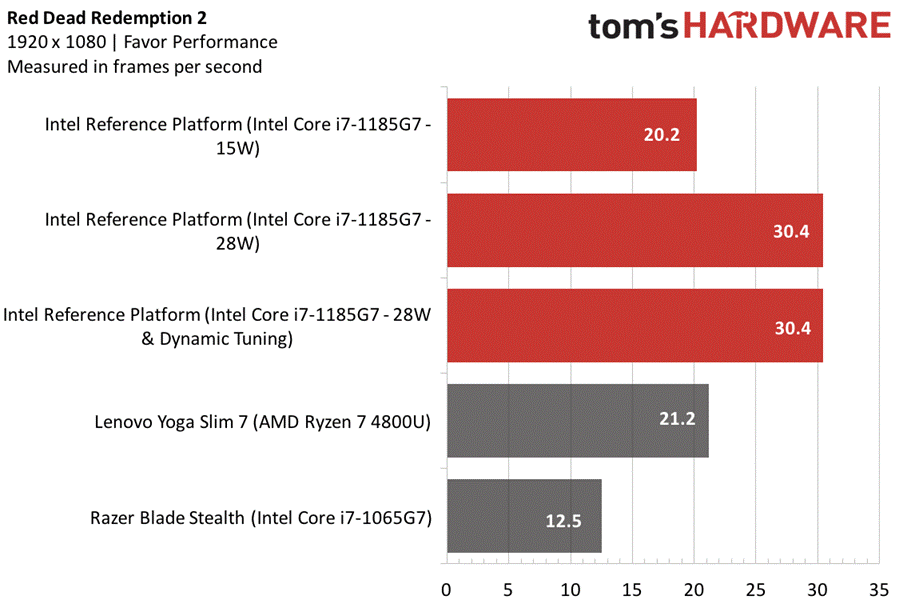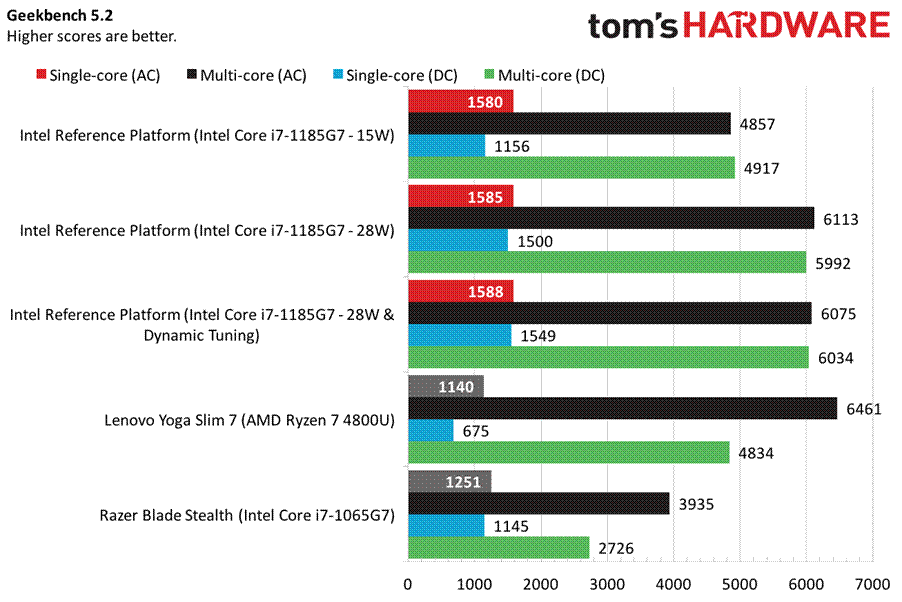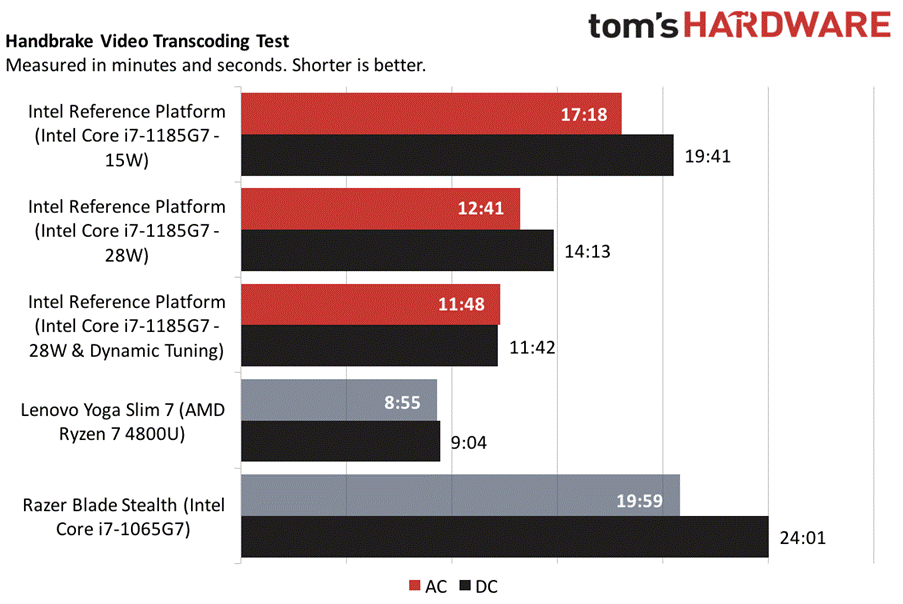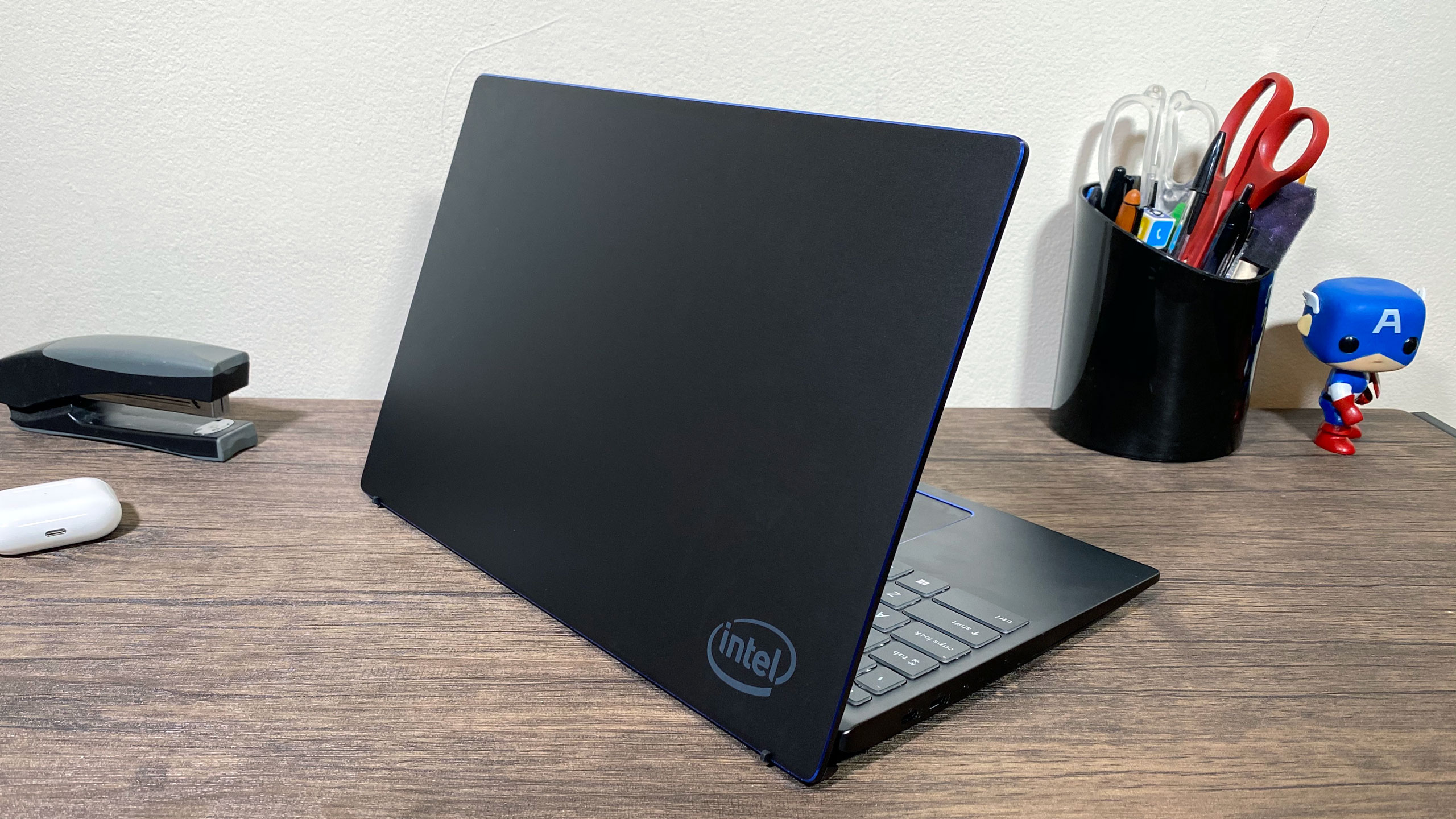Tiger Lake Tested: We Benchmark Intel’s Latest With Iris Xe Graphics and 10nm SuperFin
SuperFin and Xe Graphics make their mark.
A lot changes in a year. At this time in 2019, Intel had finally released its 10th-Gen Ice Lake processors, moving its laptop CPUs over to the 10nm process node. It was a tick after so many tocks, but the company had difficulties sustaining high clock speeds on its then-under-performing 10nm node. As a result, Intel was forced to use its 14nm Comet Lake processors to satiate the high-performance segment of the laptop market, while leveraging Ice Lake's improved graphics engine for laptops geared for gaming on integrated graphics.
But in 2020, things look a lot different. Intel's split product stack hasn't been able to keep pace with AMD’s 7nm Ryzen 4000 series chips. AMD's new platform is more efficient, leading to superior battery life, and it's more powerful in key applications. That success has led to broader adoption of the Ryzen "Renoir" chips, and now we’re seeing them in more laptops than ever.
And that’s why the success of Tiger Lake, Intel’s 11th-Gen family of mobile processors, is critical to the company. Intel has made a slew of targeted adjustments to its 10nm node, resulting in a re-vamped process that it calls 10nm SuperFin, and it brings up to 20% higher clock speeds and better power efficiency.
Paired with the new Willow Cove microarchitecture, Intel says Tiger Lake brings a dizzying array of improvements over the company's previous-gen Ice Lake with a doubling of graphics performance, the first PCIe 4.0 support for laptops, and support for LPDDR4-4266 memory. Whip in integrated Thunderbolt 4 and Wi-Fi 6, and Intel thinks it can compete with AMD's finest not only in performance, but also in features.
As Intel deals with issues with yet another delay, this time to its 7nm chip production, this new portfolio of tech will be urgently important to help it regain its footing against its nimble competitor.
Tiger Lake isn't coming to market until the fall, but Intel gave us a chance to go hands-on with a reference laptop to see just how well it performs in various benchmarks.
Intel promises 50 designs will be on the market before the holiday, and around 150 total designs will land over time. We’ve already seen some announcements, like the Lenovo Yoga 9i, Acer Swift 5 and MSI Summit, which will show up soon.
Get Tom's Hardware's best news and in-depth reviews, straight to your inbox.
With Tiger Lake, Intel is the first to bring PCIe Gen 4 to laptops (AMD had that honor on desktops), as well as Thunderbolt 4. Some 11th-Gen chips are debuting with Intel’s Xe LP graphics, which the company markets as Intel Iris Xe.
Intel says the new graphics engine offers up to twice the performance-per-watt of the Gen11 graphics found on Ice Lake, meaning it's faster and should also deliver longing gaming sessions between battery charges. Now that we have Intel's reference system in the lab, we can see if Xe will finally allow for meaningful 1080p gaming on integrated graphics.
Notes on Testing
You can’t test a mobile CPU without a laptop to put it inside. So this isn’t a review of a Tiger Lake chip, but more of a preview of what you can expect from OEM laptop systems. You can expect full reviews of Tiger Lake systems when we see the Core i7-1185G7 and the rest of the 11th-Gen lineup in laptops that people can actually buy.
Intel loaned reviewers what it refers to as the Intel Reference Design, a pre-production “white box” system with the quad-core, eight-thread Core i7-1185G7 that isn’t necessarily representative of a final system we will see for sale at a later date. Intel only allowed testing based on performance, so we couldn’t test battery life, thermals, or Thunderbolt 4 performance (not that we had the devices to do that). We also weren’t allowed to publish photos of the laptop’s internals.
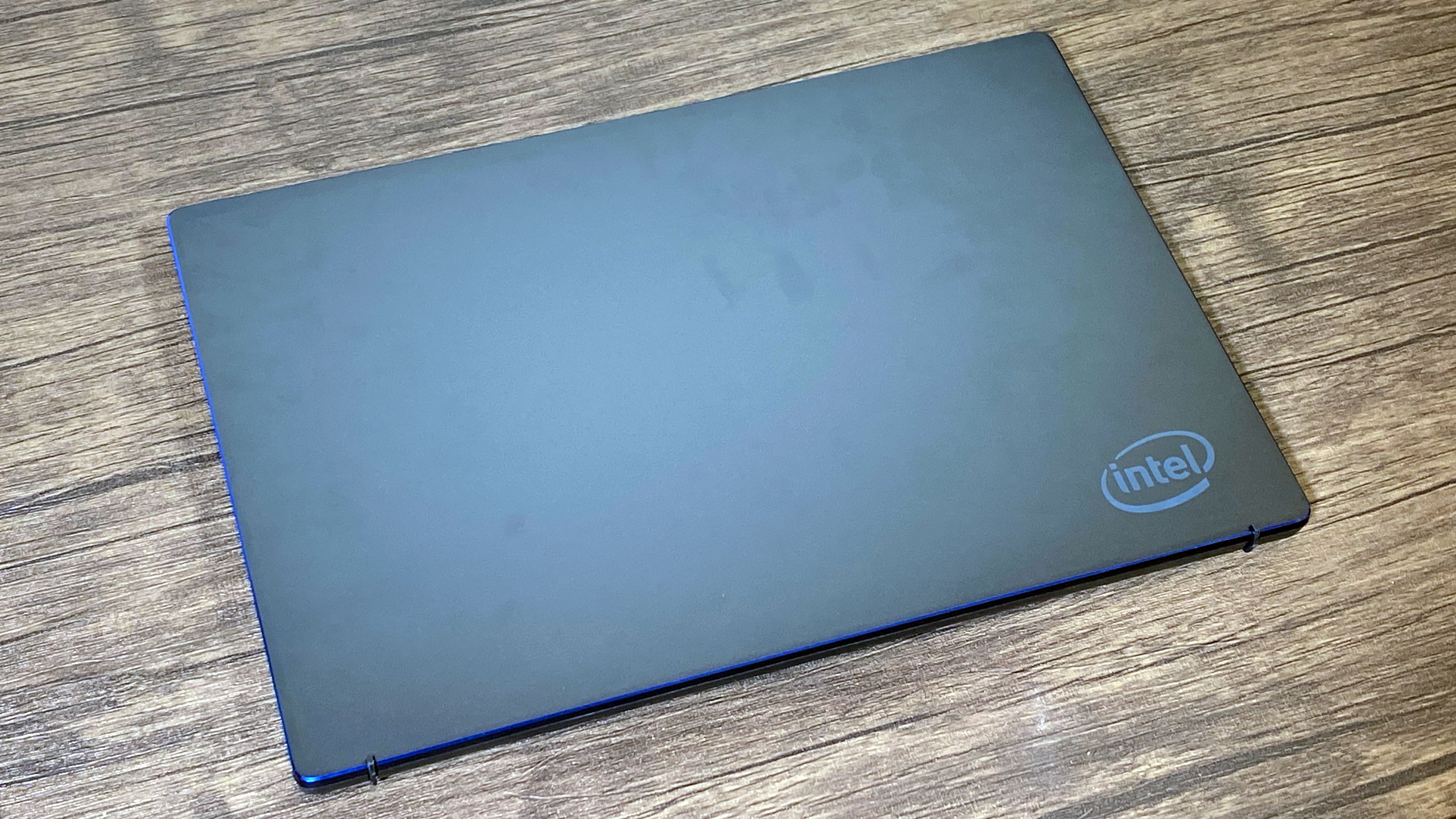

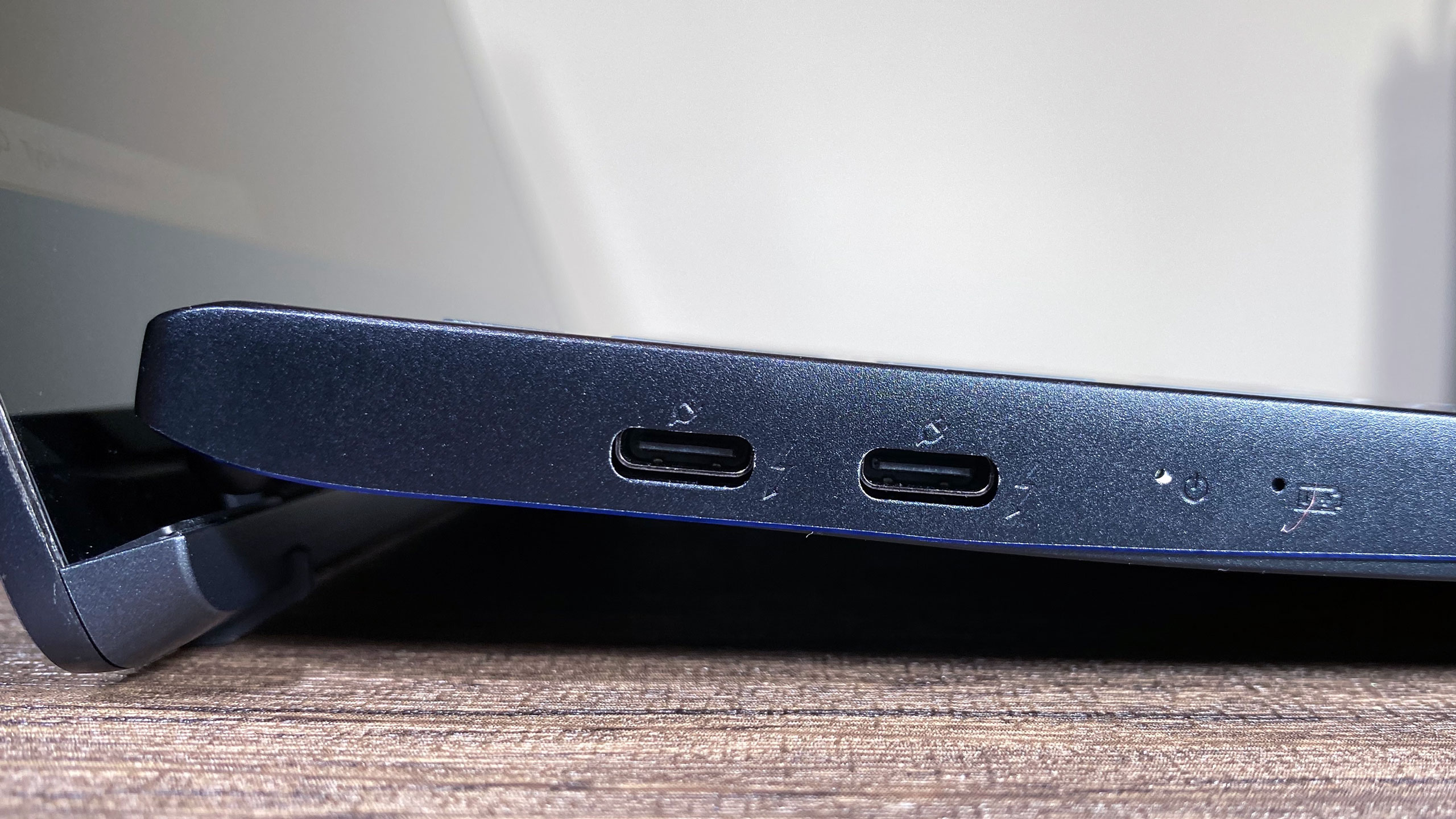
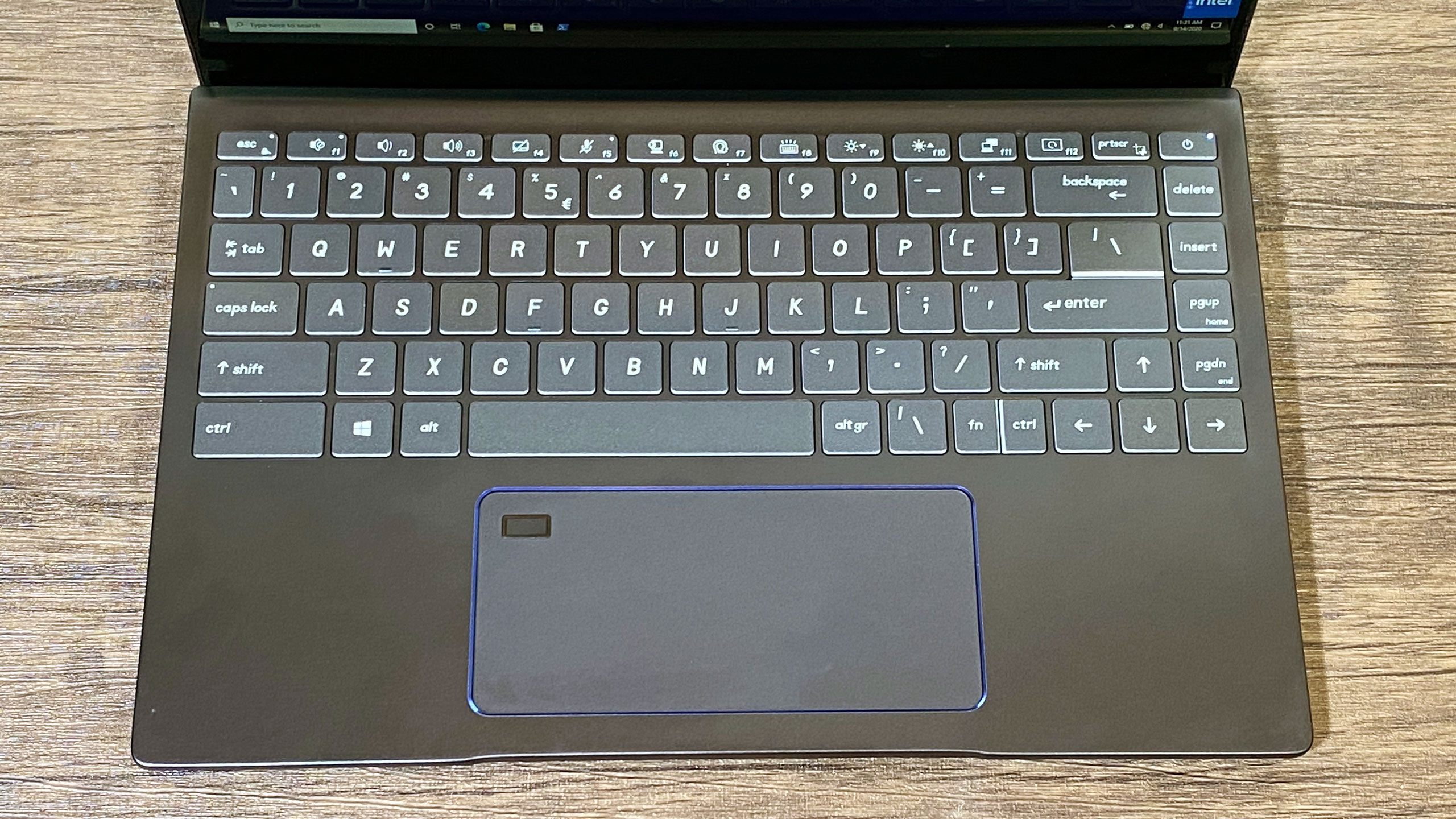
Intel warned us that the drivers are not final, and some software hasn’t been optimized for the new chips. Like the early sample Ice Lake system we saw last year, the system could switch between power envelopes, this time between 15W, 28W and 28W with dynamic tuning. This switcher won’t be available in the final systems, but OEMs can configure the chips. It’s handy for us, though, because it means we can test at different power thresholds to emulate different classes of notebooks.
Much of our test suite includes benchmarks that we use in our reviews, including the latest version of Geekbench 5, our Handbrake test, 3DMark for graphics and Cinebench R20 looped 20 times as a stress test. Of course, with the claims Intel makes about gaming on Iris Xe graphics, we decided to test more games than we would on the average ultrabook.
Intel Reference Design and Competitors
The Tiger Lake reference design came with the following specifications:
| CPU | Intel Core i7-1185G7 (15W/28W/28W with dynamic tuning) |
|---|---|
| GPU | Intel Iris Xe Graphics (96 EUs) |
| RAM | 16GB LPDDRX-4267 MHz (dual-channel) |
| Storage | 1TB Samsung PM981a M.2 PCIe Gen 3 NVMe SSD |
| Display | 14-inch, 1920 x 1080 |
| Networking | Intel Wi-Fi 6 AX201 2x2 |
| Ports | 2x Thunderbolt 4 |
| Operating System | Windows 10 Pro 2004 |
On hand, we had the Lenovo Yoga Slim 7 (known as the Lenovo IdeaPad Slim 7 in North America) with a Ryzen 7 4800U, AMD’s top-end competitor in the mobile space with eight cores and 16 threads. We also had the latest Razer Blade Stealth 13, with a 25W Intel Ice Lake Core i7-1065G7.
For each of those laptops, we applied all of the latest patches, fixes and updates available. While Intel’s system came with Windows 10 version 2004, neither our Slim 7 nor Blade Stealth had 2004 ready for rollout. We could have forced the update, but that could potentially cause stability issues, so we left those on version 1909.
The Blade Stealth has a GTX 1650 Ti Max-Q, but we disabled it when we tested, relying instead on the system’s Gen11 Iris Plus graphics.
Unfortunately, we did not have a comparable 14nm, 10th-Gen Comet Lake-U system availability for comparison, so on the Intel side, it’s 10nm vs 10nm.
The other downside to testing mobile chips is that because they’re designed directly into laptops, they have different configurations, chassis and even cooling systems, which means performance varies. Given the circumstances, this is as close as we could get to conducting a meaningful series of tests that would be representative of final shipping products. But it isn’t perfect.
| Lenovo Yoga Slim 7 | Razer Blade Stealth 13 | |
|---|---|---|
| CPU | AMD Ryzen 7 4800U | Intel Core i7-1065G7 (25W) |
| GPU | AMD Radeon Graphics | Intel Iris Plus Graphics (Nvidia GeForce GTX 1650 Ti Max-Q disabled) |
| RAM | 16GB DDR4-4266 MHz | 16GB LPDDR4-3733 MHz |
| Storage | 512GB SK Hynix PCIe M.2 SSD | 512GB Samsung PM981a M.2 PCIe NVMe SSD |
| Display | 14-inch, 1920 x 1080 | 13.3 inch, 1920 x 1080 |
| Networking | Intel Wi-Fi 6 AX 201 (2x2) | Intel Wi-Fi 6 AX 201 (2x2) |
| Operating System | Windows 10 Home 1909 | Windows 10 Home 1909 |
Here’s how the processors stack up on paper:
| Cores / Threads | Process Node | Base Frequency | Max Turbo Frequency | TDP | |
|---|---|---|---|---|---|
| Intel Core i7-1185G7 | 4 / 8 | 10nm SuperFin | 1.2 GHz (12W), 3.0 GHz (28W) | 4.8 GHz | 12 - 28W (configurable) |
| AMD Ryzen 7 4800U | 8 / 16 | 7nm | 1.8 GHz | 4.2 GHz | 10 - 25W (configurable, 15W default) |
| Intel Core i7-1065G7 | 4 / 8 | 10nm | 1.3 GHz | 3.9 GHz | 12 - 25W (configurable) |
Productivity Performance
First, we ran some of our usual productivity benchmarks to compare 11th Gen vs. 10th Gen and AMD’s best.
In Geekbench 5.2, the Tiger Lake system showed off in single-core performance, with scores starting at 1,580 at 15W and going up to 1,588 at 28W and dynamic tuning. The Yoga Slim 7, with an AMD Ryzen 7 4800U, was still the overall winner in multi-core performance with a score of 6,461 (more cores certainly helps there), though the i7-1185G7 came close at higher wattages (6,113 at 25W, but 4,857 at 15W).
The Yoga Slim 7, with a score of 1,140, lost not only to Tiger Lake in single-core performance, but also Ice Lake (1,251).
For our Handbrake tests, we transcode a 6.6GB 4K video to 1080p. Here, the Ryzen 7 4800U remains the king, completing the task in 8 minutes and 55 seconds. At 15W, the Intel Reference Platform took 17 minutes and 18 seconds, which marks gains over Ice Lake (19:49). At 28W with dynamic tuning, Intel’s laptop performed the same job in 11:48, which is an impressive gain, but not on the same level as the Ryzen 7 4800U.
We run Cinebench R20 on a loop 20 times to stress test laptops. The multi-core test is difficult, and the Lenovo Yoga Slim 7, with eight cores, easily took the crown with scores in the high 2,700’s and an average CPU speed of 2.5 GHz.
At 15W, the reference system had an average score of 1,553.7 and an average clock speed of 2.5 GHz. At 28W, the score bumped up to 2090.1 as clocks jumped to 3.3 GHz. With dynamic tuning at 28W, it notched an average score of 2,159 and an average speed of 3.5 GHz.
Sensors suggest that the Core i7-1185G7 throttled on occasion, though it’s hard to know if that’s due to the chip, unfinished drivers or software recognition, or even the cooling on the reference platform.
Gaming and Graphics Performance
With Tiger Lake, we’re getting our first look at Intel’s Xe LP graphics, which Intel calls Iris Plus Xe. Can we finally play games on an ultrabook at 1080p? Sort of.
Before we got to games, we started with 3DMark Night Raid, UL’s DirectX12 benchmark for systems with integrated graphics.
At 15W, the i7-1185G7 notched a score of 13,801, falling just short of the Yoga Slim 7 with the Ryzen 7 4800U (14,053). But at 28W, the top-end Tiger Lake took the lead with a score of 17,797. Either way, it made the 10th-Gen Ice Lake part, at 7,446, look like a joke.
Tomb Raider on its lowest preset with SMAA anti-aliasing enabled, all at 1920 x 1080. At 15W, the Intel Reference System hit an average of 30 frames per second. Because it sometimes went below 30 fps, it’s not exactly playable. But at 28W, it reached 42 fps, which is far more stable. The Ryzen 7 4800U’s Radeon graphics reached 33 fps.
We saw a similar pattern on Borderlands 3. We ran that game’s benchmark on the low preset with DX12. Here, the 15W reference platform fell short at 25.4 fps. At 28W, it came closer to 32 fps, just beating the Ryzen 7 4800U (30.4 fps) by a bit over a frame.
Due to both its age and the fact that it’s more CPU dependent than many of our other benchmarks, the Grand Theft Auto V benchmark on normal settings ran fairly well across our entire test suite, with both the Core i7-1185G7 and Ryzen 7 4800U allowing for averages over 60 fps. At 15W, the Intel system just made it (60.8 fps), but at 28W, it averaged in the upper 70’s.
Even Ice Lake ran the game at an average of 40.6 fps.
Far Cry New Dawn proved a challenge. Neither the Yoga Slim 7 nor the reference system running at 15W cleared 30 fps at low settings. But at 28W, the Tiger Lake chip ran above the threshold.
Just for fun, we whipped out Red Dead Redemption 2, which we tend to run on medium for our enthusiast gaming desktop and laptop benchmarks. But here, we ran it on its lowest settings under the “favor performance” preset.
At 15W, the Core i7-1185G7 couldn’t pull it off (20.2 fps), and nor could the Yoga Slim 7 (21.2 fps) nor the Stealth (12.5 fps). And 28W, though, the Intel Reference Platform pulled just over 30 fps with an average of 30.4 fps.
All of this is to say that, if you’re willing to compromise greatly on fidelity, you can run many games at 1080p on a laptop with Iris Xe graphics. It won’t be one of the best gaming laptops, and the heaviest games may still pose an issue, but Intel has made some great strides here, as long as you have the option to use it configured at 28W.
Plugged vs. Unplugged Performance
One of Intel’s big promises during the Tiger Lake reveal was that the chip would run about as powerfully when your laptop is unplugged as when it is connected to a charger.
In Geekbench 5.2, the claims, more or less, seemed solid. Scores didn’t match up exactly, particularly for single-core performance at 15W, but Tiger Lake was closer at 28W. The AMD Ryzen 7 4800U was far less powerful while unplugged, and the Ice Lake Core i7 also didn’t hold up.
On Handbrake, We saw ever-so-slightly slower performance, with one exception: the i7-1185G6 with Dynamic Tuning actually ended up being slightly faster unplugged. Despite a poor showing in Geekbench, the Ryzen 7 4800U did well unplugged in Handbrake.
Memory Throughput / Latency
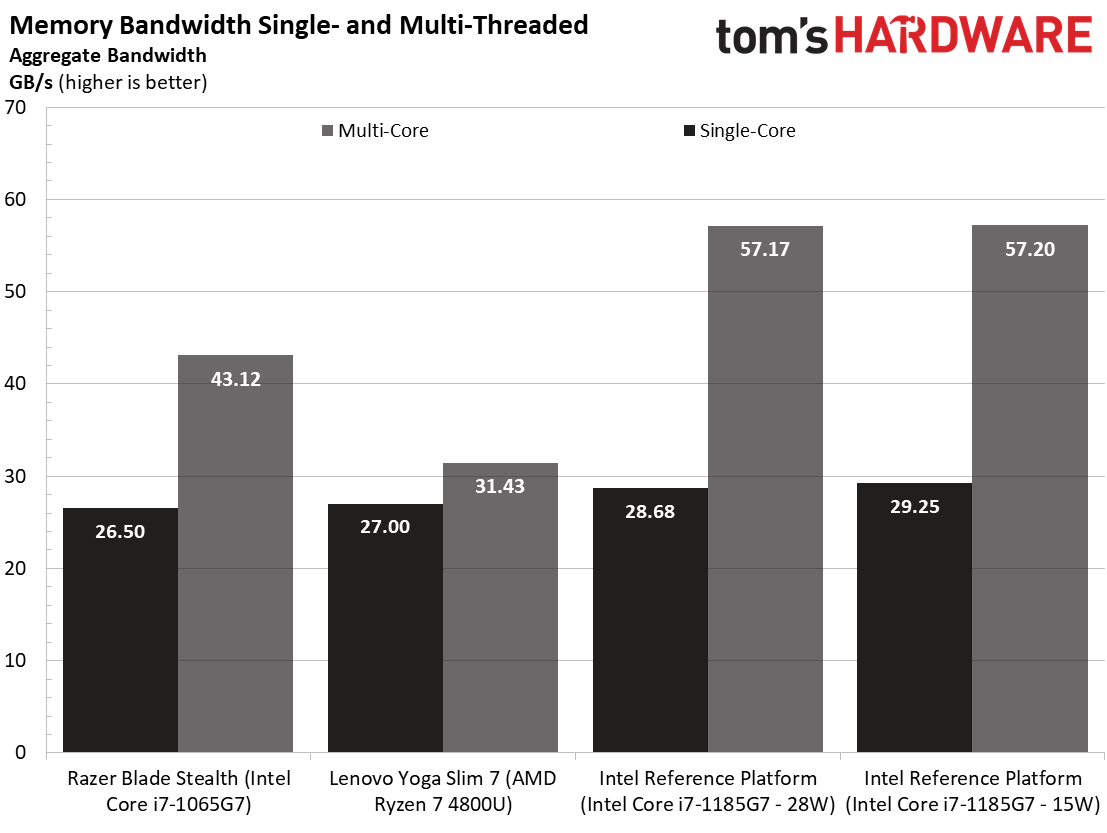

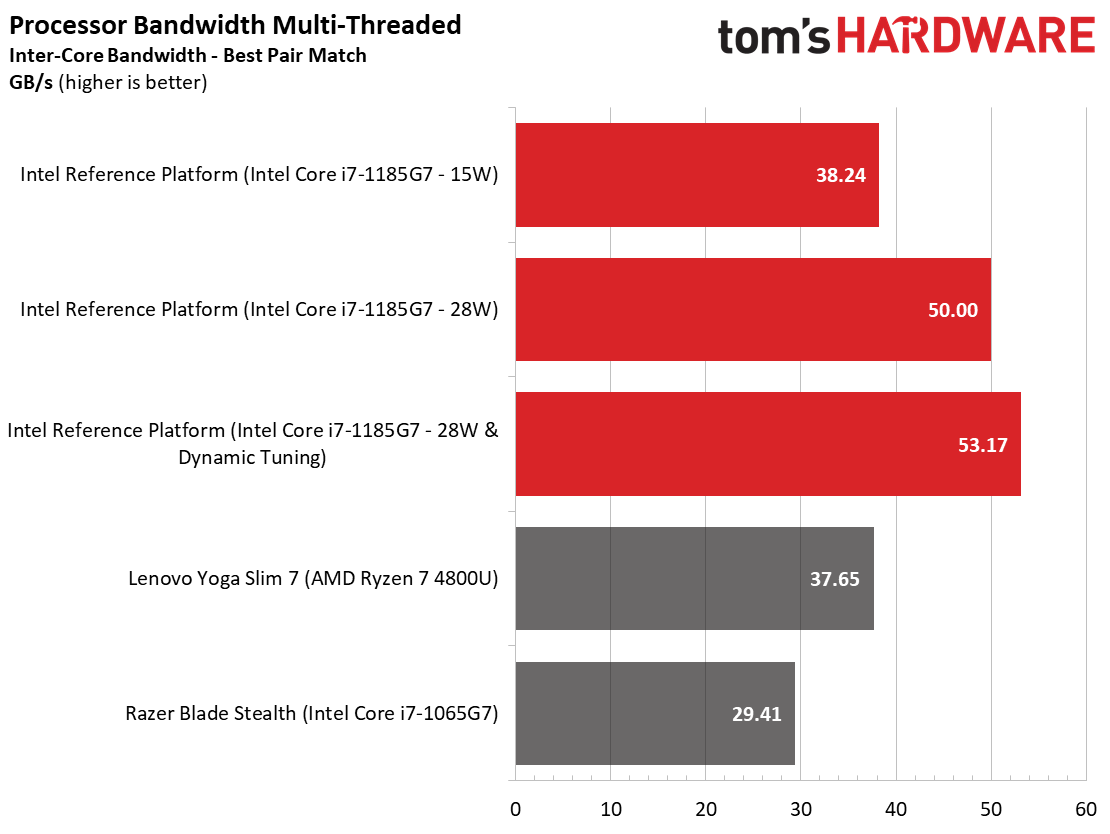

Intel has made several improvements to the underlying microarchitecture of the chip, including beefing up the memory subsystem by moving from LPDDR4-3733 to LPDDR4x-4266 memory. That has an impact not only on traditional compute operations, but also for graphics.
Here we can see the impact of the step up to LPDDR4x-4266, which shows up as a jump to ~57 GB/s of throughput from Ice Lake's 43 GB/s if we access the memory from all cores simultaneously, a 32% improvement. That's also nearly twice as fast as the Ryzen 7 4800U's multi-core bandwidth. Tiger Lake's doubled bandwidth also bodes well for the on-chip network's ability to feed the Xe LP graphics engine, which helps explain the big advances in our gaming results. For single-core work, we also see an improvement from Ice Lake's 26.5 GB/s of bandwidth to ~29 GB/s.
SiSoftware's Sandra is used to measure cache and memory latency with three different access patterns, giving us more granularity than a single test. Sequential access patterns are a good measure of prefetcher performance. The in-page random test measures random accesses within the same memory page and represents best-case random performance. The full random test features a mix of TLB hits and misses, with a strong likelihood of misses, quantifying worst-case latency.
We see the fruits of Intel's memory and fabric improvements in the latency measurements, with a ~10% reduction for in-page random accesses, a 17% improvement in full random latency, and a ~15% improvement in sequential access latency.
With the move to more robust caches and faster memory, it's only natural that the on-chip fabrics have to improve in lockstep. Intel also revamped its ring bus architecture to a dual ring bus, which is essentially two bi-directional ring busses wrapped within one another. This speeds data transfer between the chip elements, like caches, cores, and the graphics engine, which allows the chip to deliver that increased memory throughput to the chip elements, but it also reduces contention.
Intel added the ability to downclock Tiger Lake's fabric and memory subsystem independent of the processing cores, saving power. That technique can result in a tradeoff in some types of workloads, and we see signs of that in our multi-threaded processor bandwidth test. This test focuses on ring bus bandwidth, specifically, and we can see an improvement when the Tiger Lake chip runs in dynamic mode, which is designed to boost performance. That implies the chip isn't throttling back the ring bus to save power during this test. We can also see that, even in the 15W configuration, Tiger Lake's dual ring bus delivers slightly more throughput than the 4800U's Infinity Fabric, and has 30% more throughput at 28W with dynamic tuning. Tiger Lake's fabric is also less latent than Ryzen's but surprisingly trails the Ice Lake chip slightly.
AVX-512, Cryptography, Multi-Media and Image Processing
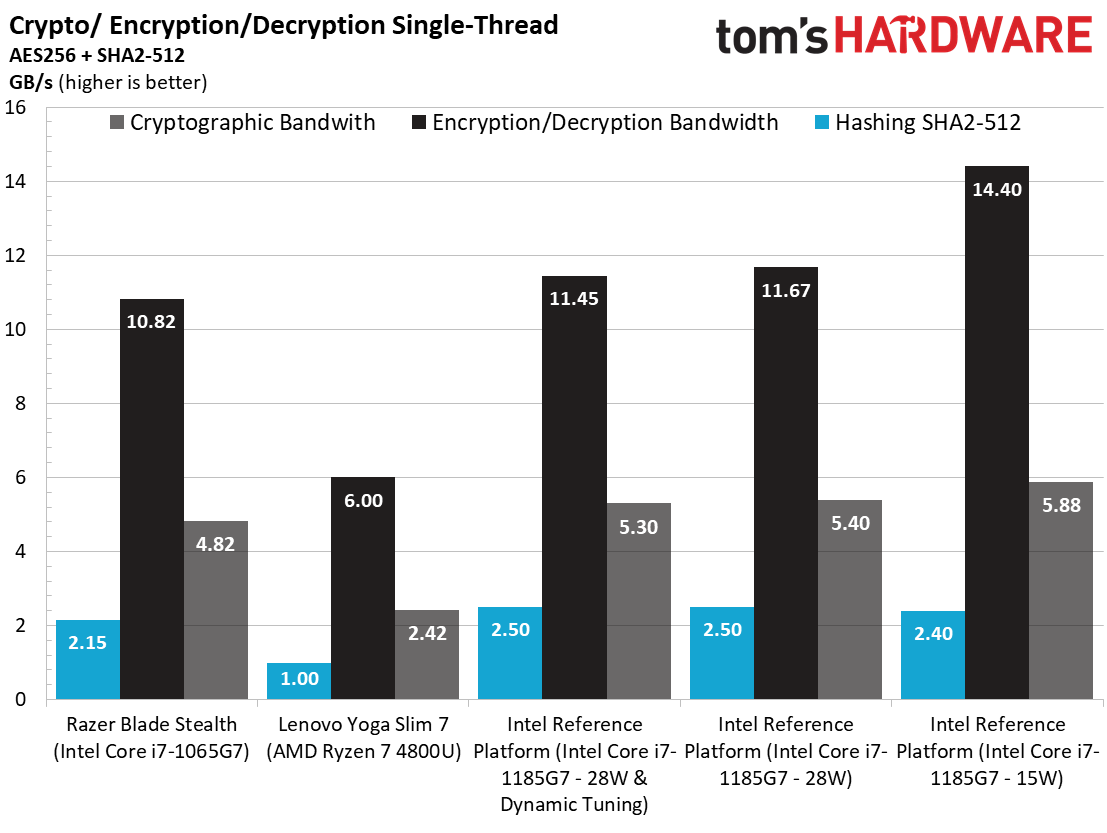

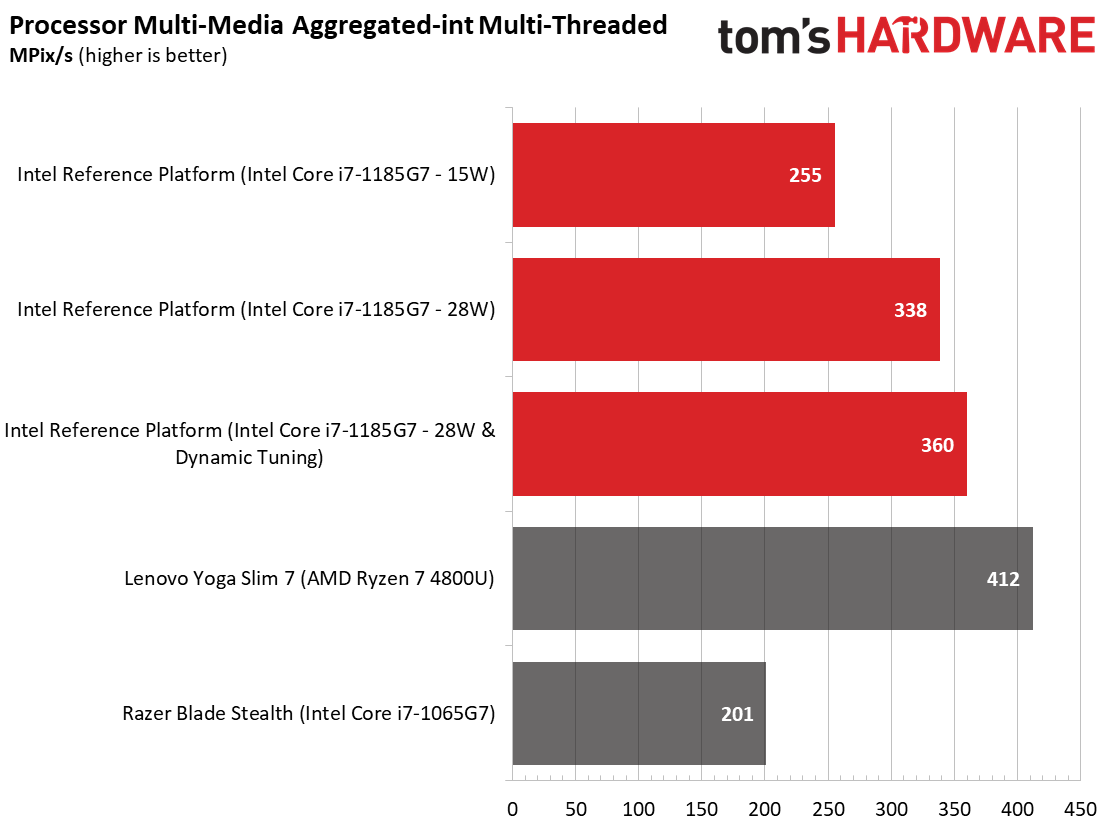
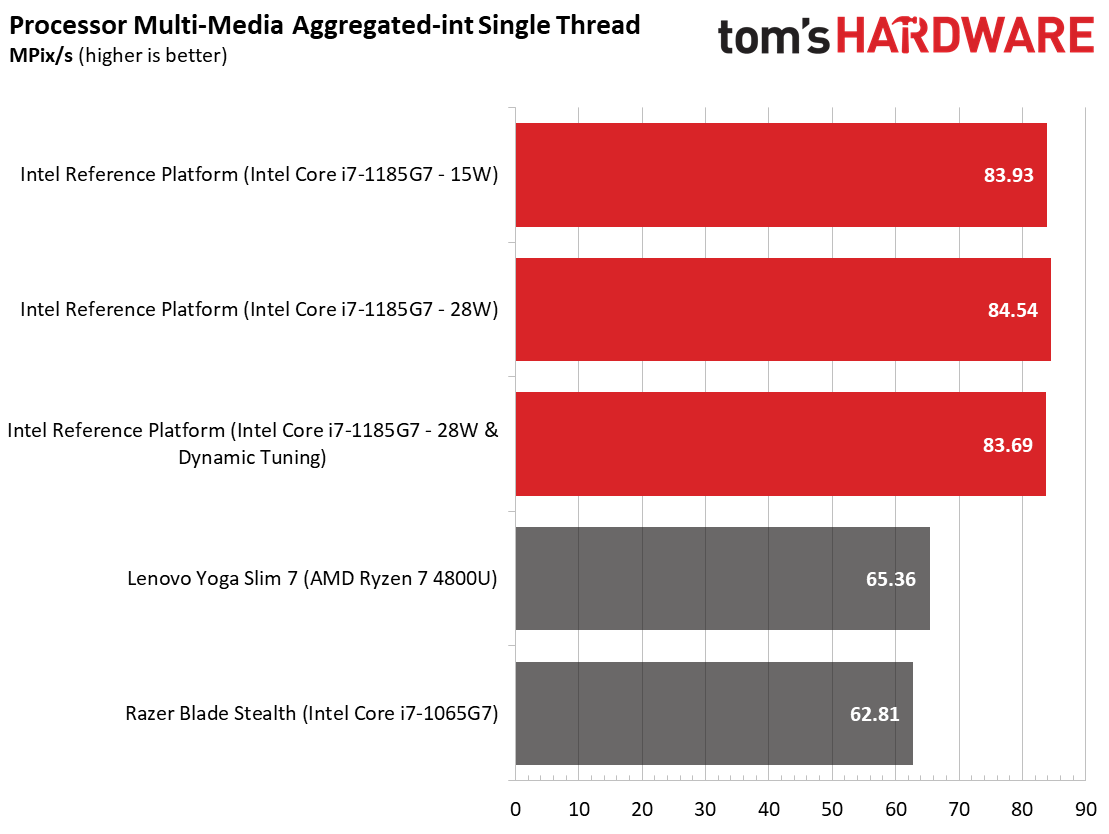

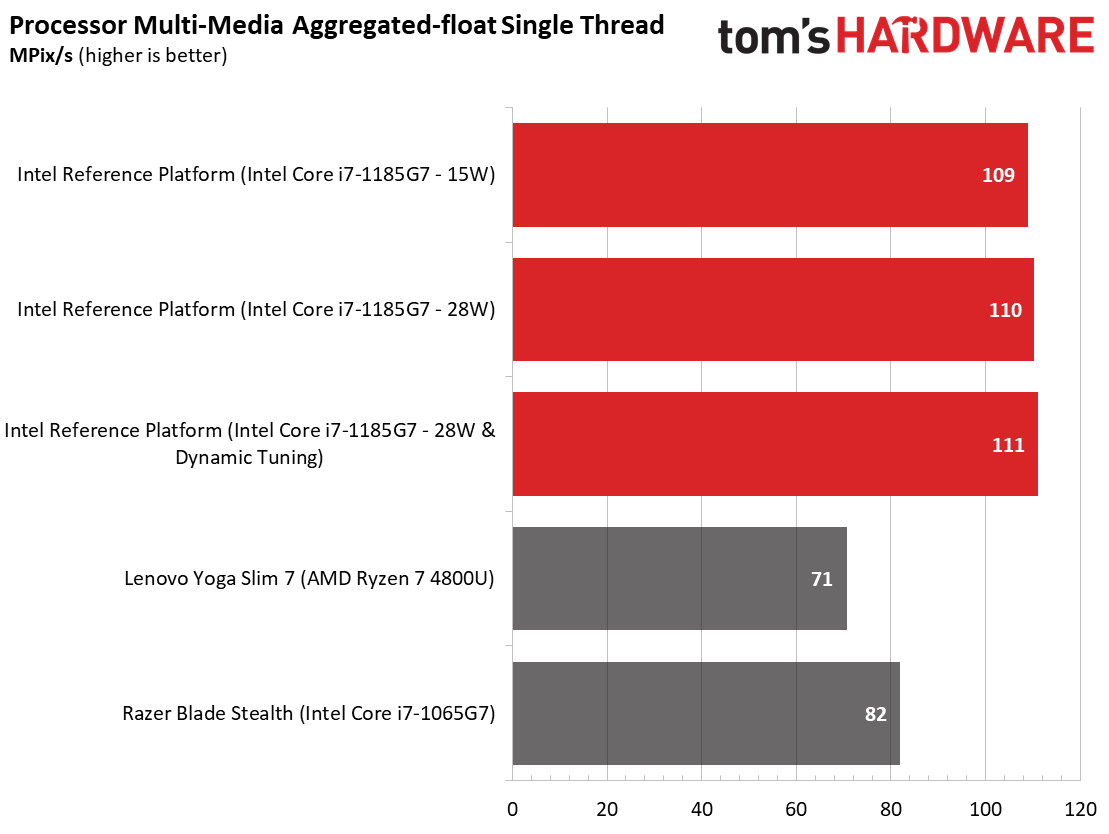

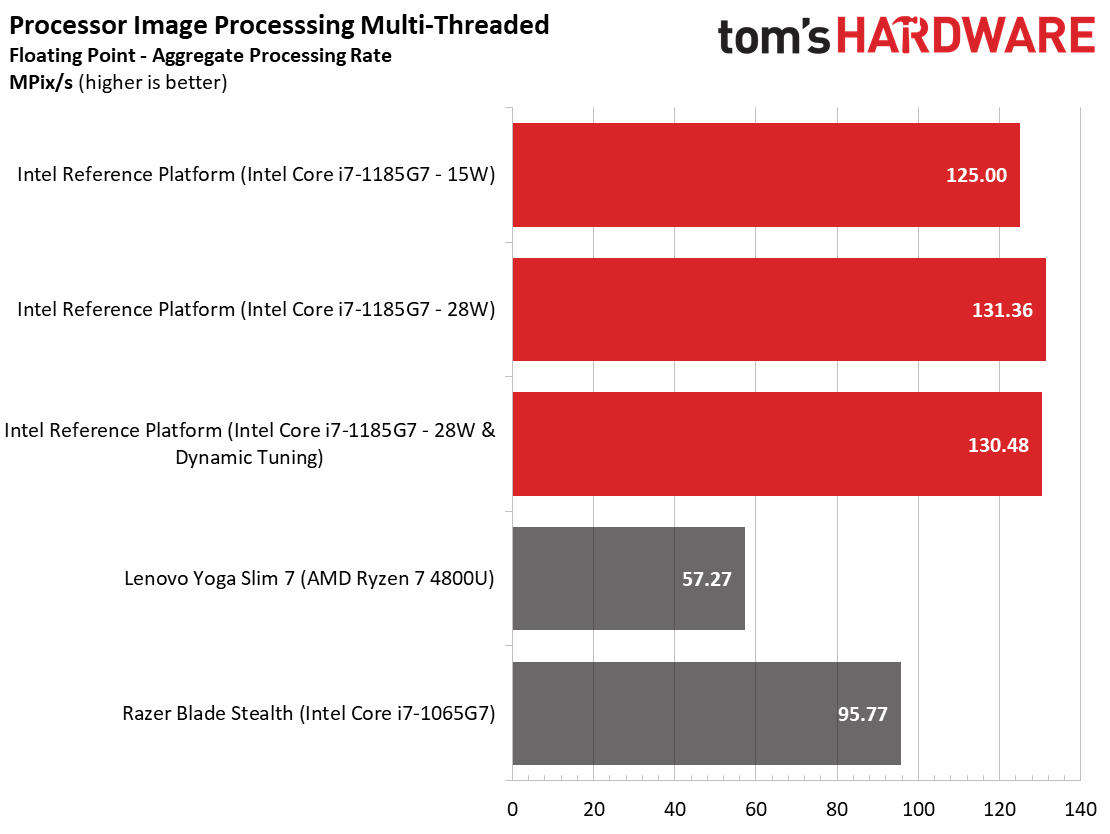

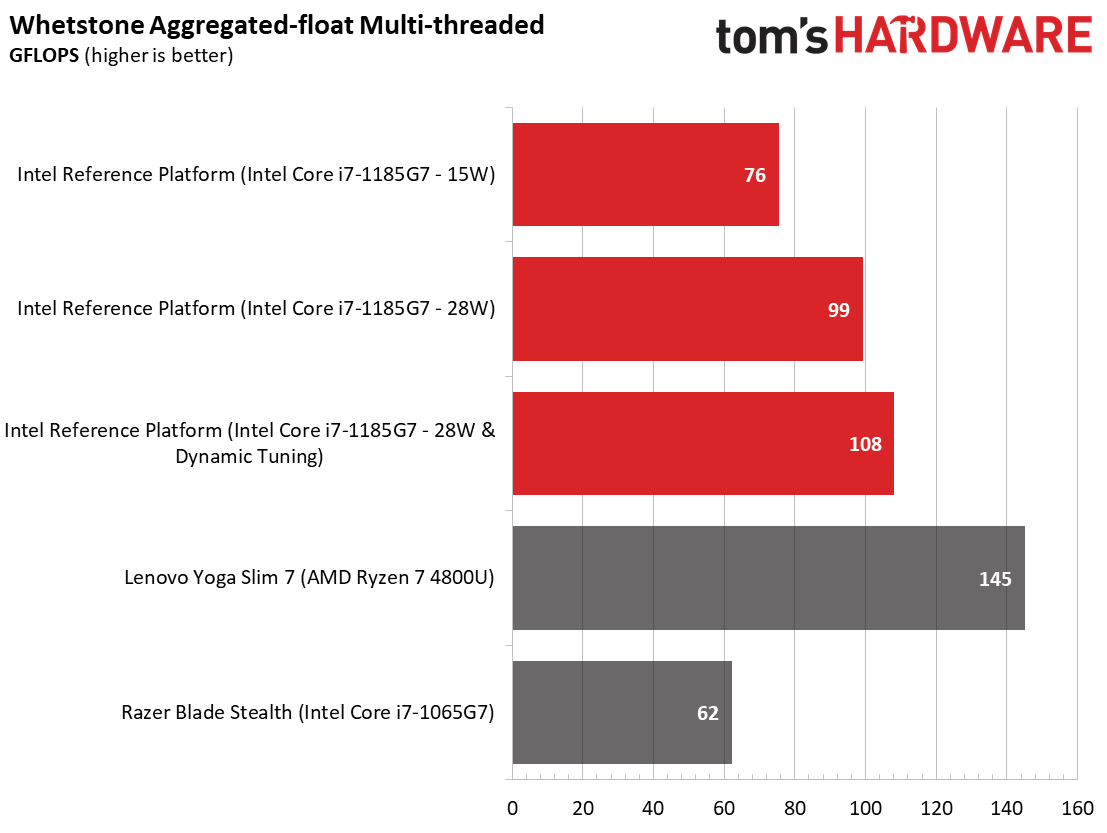
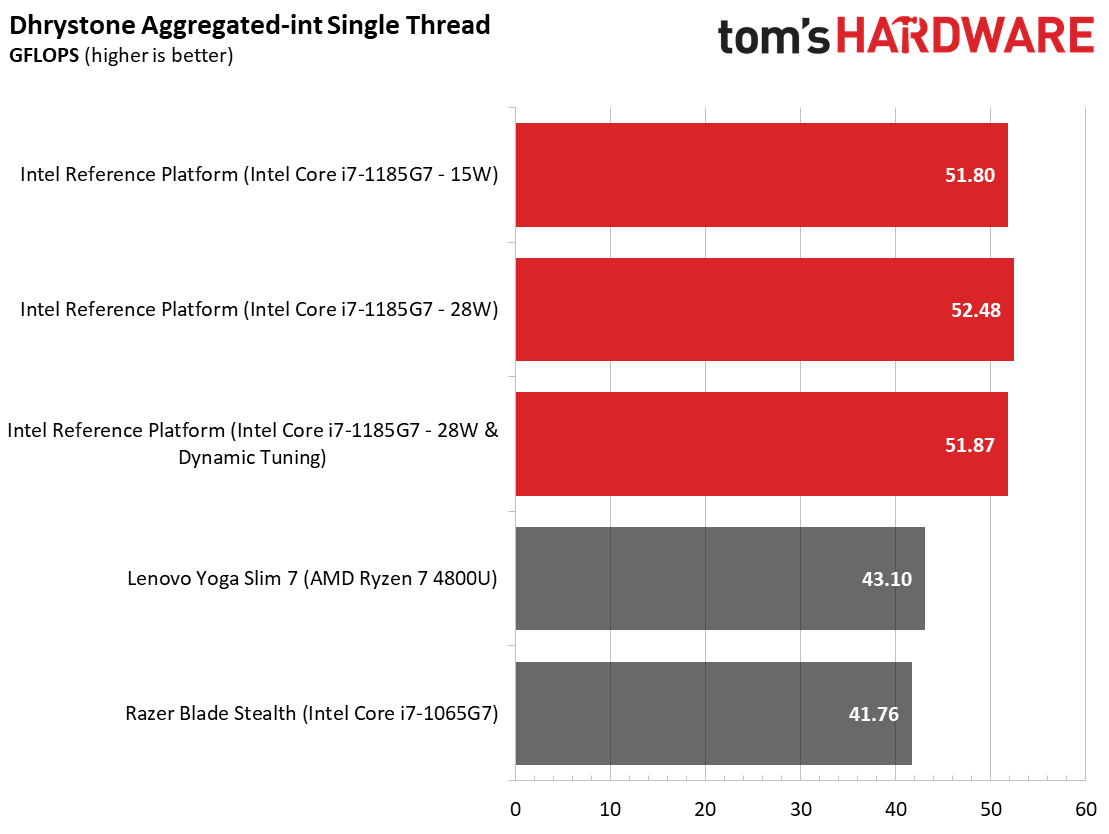

You may not think about cryptography and encryption/decryption much, but your laptop does this type of work in the background during web browsing sessions, ensuring safety and (hopefully) that your credit card info isn't stolen, among other things. This type of work can also leverage densely packed AVX-512 instructions, which highlights one of Intel's key focus areas with Tiger Lake. Here the single-threaded results are likely most relevant to casual users, as you are unlikely to be doing an all-core encryption workload very frequently. Tiger Lake excels in these tests, notching a solid advantage over Ice Lake, and an even larger advantage over the Ryzen 7 4800U. Intel's gains relative to Ryzen are most pronounced with the SHA2-512 hashing workload, where it notches more than a 2X gain. Even spreading the workload out over all of the cores, which gives Ryzen the advantages of its doubled core/thread count, doesn't improve its standing much. That said, you shouldn't base your purchasing decision solely on this type of workload, but it does show the hidden powers of AVX-512 - it would be nice if the software ecosystem would adopt it more broadly.
The processor multi-media test measures processor performance during mandelbrot fractal generation, but it uses various flavors of SIMD instructions. Tiger Lake notches big wins in single-threaded performance, but trails in multi-core work as the Ryzen system leverages its doubled core count.
The processor image processing test also uses AVX instructions to improve performance, and we can clearly see Tiger Lake's advantage in both series of single-threaded tests, with both integer and floating point. That high per-core performance translates to more aggregate performance than the Ryzen system when we spread the workload over more cores, allowing the Tiger Lake platform to beat Ryzen, but with half the cores (particularly with floating point).
Artificial Intelligence / Machine Learning



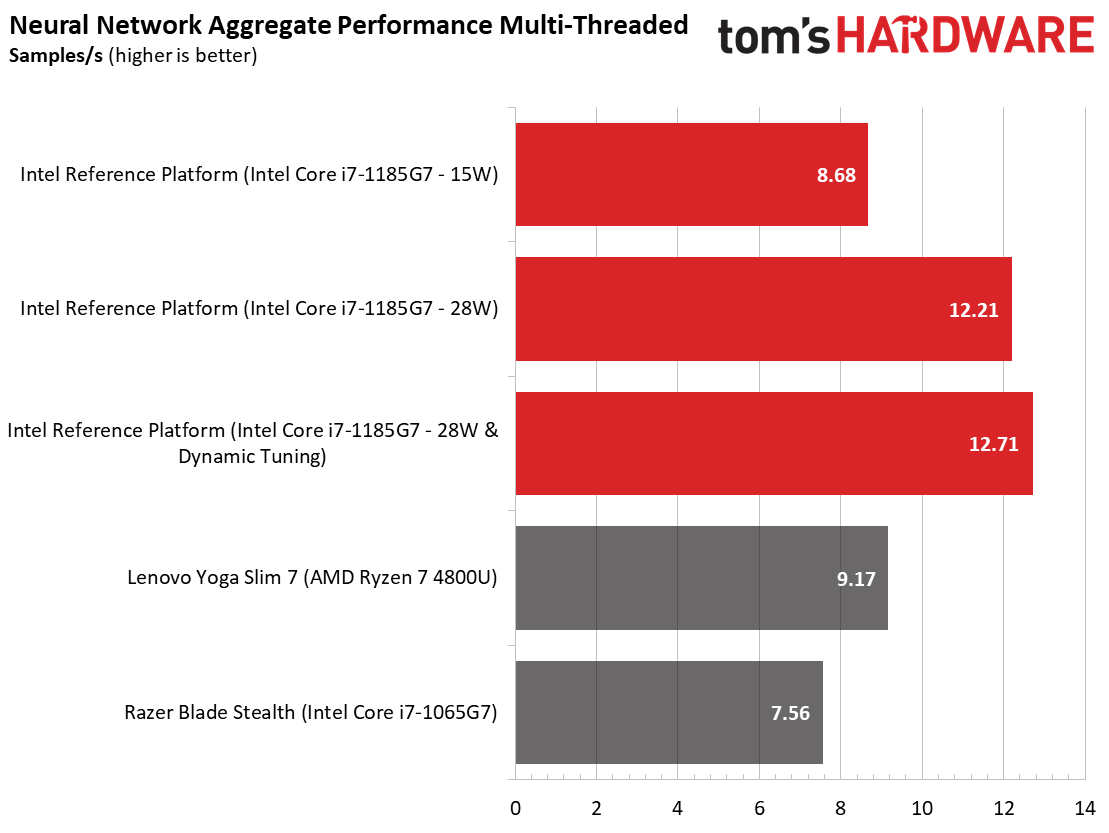
Here we compare Tiger Lake's performance in recurrent and convolutional neural networks (RNN/CNN) in both inference and training.
These RNN/CNN neural networks are used for image processing and classification, respectively, with the two inference tests being the most impactful for typical desktop PC use. Intel hopes that the number and types of programs that use AI to boost performance will grow over the coming years, and here we can see why. Intel's Tiger Lake offers more performance in the multi-threaded inference tests than the Ryzen system, and again, with half the number of cores. That bodes well for the future eight-core models. However, only a few applications currently support AI acceleration, so you shouldn't base a purchasing decision on the new tech unless you frequently use AI-accelerated applications. However, it should go without saying that support for AI acceleration is growing at a rapid clip.
Impressions
It’s hard to get the full view of how Tiger Lake will perform in OEM laptops. After all, our preview had some conditions attached to it that limited the scope of our testing, and we’ve yet to see the final designs that people will actually be able to buy.
But we do, however, see an idea of how things will be. Tiger Lake’s 10nm SuperFin technology appears to be competitive with AMD’s top-end Ryzen 7 4800U at 15W, and, at 28W and with Dynamic Tuning, even better, at least when it comes to single-core workloads. With multi-core workloads, AMD still has the advantage on its top-end part, with double the cores and threads.
With the i7-1185 G7, Intel has finally caught up in boost speed to its 14nm process node on Comet Lake-U, but only at the 28W setting. It will be interesting to see how OEMs configure the chip to get the most performance out of it, and what that means for battery life, especially if Intel promises similar performance on battery to when it’s plugged in.
There’s still support for AVX-512, which should allow increases in performance in programs coded to take advantage of the instructions.
But the big addition is Iris Xe graphics, which, on the reference system, got us to 1080p at 30 fps in low settings on most tests. We’ll see what comes when laptop manufacturers drop their systems. Still, we’re getting closer to the point where you could reasonably squeeze in a short gaming session on an ultrathin notebook at the expense of fidelity.
Mobile chips always come as part of laptops, though, so if you’re looking for the final verdict, you’ll have to wait for the first Tiger Lake systems to hit our labs this fall.

Andrew E. Freedman is a senior editor at Tom's Hardware focusing on laptops, desktops and gaming. He also keeps up with the latest news. A lover of all things gaming and tech, his previous work has shown up in Tom's Guide, Laptop Mag, Kotaku, PCMag and Complex, among others. Follow him on Threads @FreedmanAE and BlueSky @andrewfreedman.net. You can send him tips on Signal: andrewfreedman.01
-
digitalgriffin Congrats to Intel on the massive improvements they have made.Reply
Competition is a good thing! And now consumers have a choice: Faster multi core or faster integrated graphics.
Now lets see how they do on desktop against Zen 3 and next gen mcm APU's with Navi built in. -
jortego128 Why wasnt the 4800U configured to 25W to compare its GPU like for like with the Intel at 25W? Whats the point of showing the Intel 25W config vs. the AMD locked down to 15W?Reply
Seeing how the Renoir Vega GPU barely edges out the Tiger Lake Xe GPU in all tests at 15W, it would have been very useful to show the differences at 25W. Unless Im understanding this wrong and the 4800u was configured for 25W, thats a pretty huge test to omit. -
hotaru.hino The CPU's single thread performance looks like they've made the generational leap.Reply
That graphics performance has me hopeful too as if Intel releases a discrete GPU, it'll be a good one. Maybe not the best, but at least another contender in the $250-$400 market. -
rgd1101 Reply
agree. not clear what 4800U running at.jortego128 said:Why wasnt the 4800U configured to 25W to compare its GPU like for like with the Intel at 25W? Whats the point of showing the Intel 25W config vs. the AMD locked down to 15W?
Seeing how the Renoir Vega GPU barely edges out the Tiger Lake Xe GPU in all tests at 15W, it would have been very useful to show the differences at 25W. Unless Im understanding this wrong and the 4800u was configured for 25W, thats a pretty huge test to omit.
and what the battery? power run off? and temp -
neblogai Replyjortego128 said:Why wasnt the 4800U configured to 25W to compare its GPU like for like with the Intel at 25W? Whats the point of showing the Intel 25W config vs. the AMD locked down to 15W?
Seeing how the Renoir Vega GPU barely edges out the Tiger Lake Xe GPU in all tests at 15W, it would have been very useful to show the differences at 25W. Unless Im understanding this wrong and the 4800u was configured for 25W, thats a pretty huge test to omit.
Lenovo Slim 7 with Renoir has several performance modes. I think the quiet one is 15W, then there is the default, recommended 'balanced', and also- 'extreme performance'. The latter runs at 27W sustained plugged in, 30W from battery (yes, in that order). Balanced profile- just a bit below that- though I can not remember exact wattage. Should be at about 25W though.
Hardware Unboxed have a review of 4800U in the same Slim 7, at 15W and 25W (not vs Tiger Lake though): hFYdHkvRs2cView: https://youtu.be/hFYdHkvRs2c -
st379 As other have asked was that on the extreme performance settings for the Ryzen 4800u?Reply
@PaulAlcorn I am little bit disappointed.
I see you helped write this review, I expected your usual standrad not this thing.
Where is the usual productivty test that you make? Blender, photoshop, 7-zip, handbrake, pov ray, matlab..... I am usually happy with your reviews.
I was excited and than all the air came out not seeing the more usual benchmarks and some weird ai and multi media aggregated(I have no idea what this term even mean). :( .
Usually I consider your benchmarks much better than this :(.
Will have to wait for HardwareUnboxed.
Thank you for your efforts anyway.... will just have to wait a little longer. -
rgd1101 https://www.anandtech.com/show/16084/intel-tiger-lake-review-deep-dive-core-11th-genReply
is 15w just for the based clock? single thread test is running at 50w? so many questions
anandtech did a better job -
rgd1101 Reply
not clear what this article is. not that hard to include it in the specneblogai said:Lenovo Slim 7 with Renoir has several performance modes. I think the quiet one is 15W, then there is the default, recommended 'balanced', and also- 'extreme performance'. The latter runs at 27W sustained plugged in, 30W from battery (yes, in that order). Balanced profile- just a bit below that- though I can not remember exact wattage. Should be at about 25W though.
Hardware Unboxed have a review of 4800U in the same Slim 7, at 15W and 25W (not vs Tiger Lake though): hFYdHkvRs2cView: https://youtu.be/hFYdHkvRs2c
anandtech did the test with the same 4800u laptop on 15w
fyi anandtech is our sister site.

